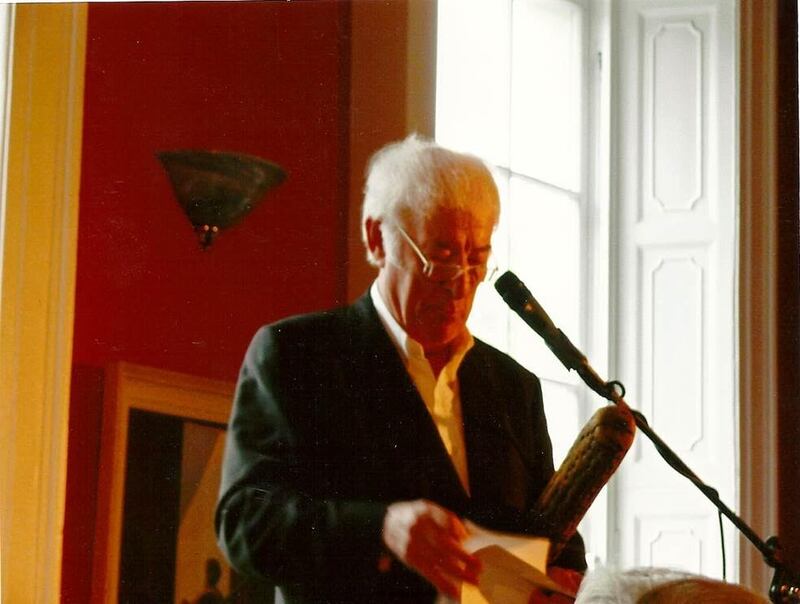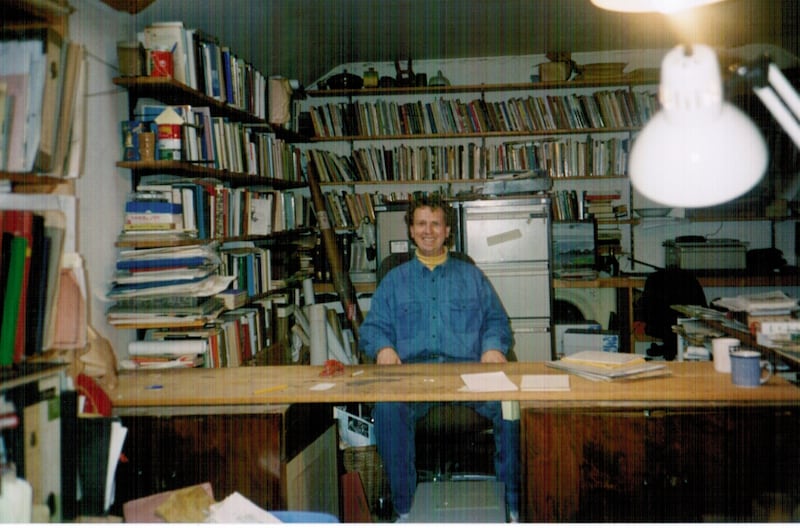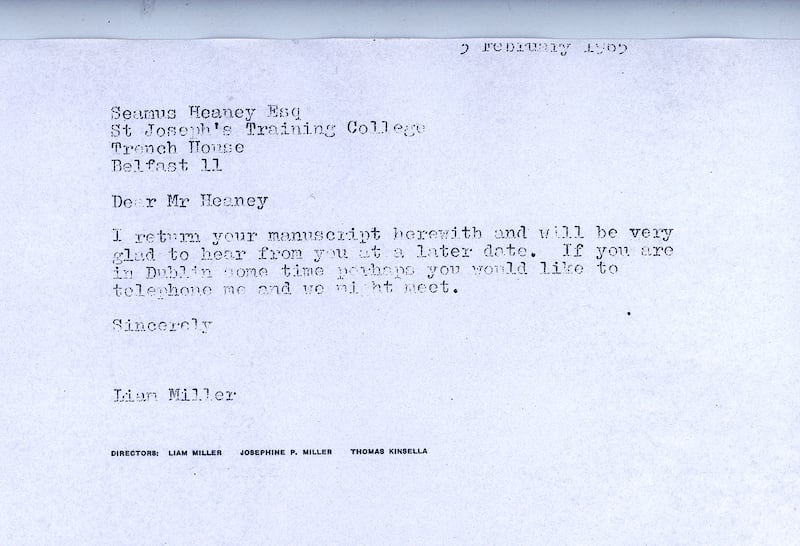As Seamus Heaney headed out the door of our home in Hickory, North Carolina, I handed him a rain stick that I pulled from my collection of world percussive instruments. The rain stick was a token of appreciation for the time he spent with us at Lenoir-Rhyne College in March 1992 (and in lieu of a real honorarium). A year later, to my surprise Heaney’s poem The Rain Stick appeared in the New Republic and it was dedicated to my wife Beth and me. The Rain Stick was later collected in Heaney’s first post-Nobel volume, The Spirit Level, where the poem assumes the place of honour by opening the work.


There is plenty going on in the poem musically and metaphorically, as Heaney comments in Stepping Stones, but I of course cannot read it without feeling that it’s about friendship among other things. I also see the placement of The Rain Stick as Seamus’s way of acknowledging the work I had done with him in his Dublin attic during the 1993-1994 academic year while I was on a Fulbright Fellowship.
Coming from a small town in southern Indiana and being the first person in my extended family to attend college, I still can’t believe that I was lucky enough to spend so much intimate time with Seamus and to have been welcomed so warmly by his family into his Dublin home. I look forward to sharing the story of my amazing journey at the Seamus Heaney HomePlace in Bellaghy next week.
Heaney turned 50 in 1989 and had been publishing for 30 years. He had also been on the Harvard faculty for 11 years. By 1993 he had published 15 volumes of poetry (including selected poems), three collections of prose works, one verse play, edited two anthologies and co-edited one anthology with Ted Hughes. Even though Heaney had administrative support at Harvard and part-time assistance in Dublin, he primarily managed his own literary affairs and did not have a literary agent to off-load/absorb some of the paperwork.
Sensing that he needed more space, literally and psychically, he agreed in 1992 to let me assist him rationalise his writing studio in the attic of his Strand Road home. The work we did during the 1993-1994 academic year was the first step towards the creation of the Heaney archives at both the National Library of Ireland and Emory University in Atlanta, Georgia.
Upon my arrival, the studio quickly became a renovation site with materials coming and going on a regular basis. In addition to materials that went into the published works, there were mounds of unpublished manuscripts, correspondence, both personal and administrative, and stacks of unsolicited manuscripts in the corners of his studio. In his office his publications claimed their territories and were accompanied by large canvas mailing bags full of hundreds of reviews clipped out of newspapers and magazines by professional clipping services, sent compliments of the publisher. We started by separating the manuscript items from the correspondence and publications. At the same time, we were reorganizing his books and bringing in storage boxes and filing cabinets.

To create more space we dismantled Heaney’s homemade desk assembled out of two boards from the pews of Carysfort College and launched a large chair out the second-story window of his home. (Heaney gave me the boards, which in 2013 became the centrepiece of Emory’s Heaney exhibition). We then began filing the loose sheets according to publishing projects or chronology and arranging his poetry notebooks in a small bookcase. The next step was to focus more closely on the organisational process itself. Periodicals were separated into “by SH” and “about SH” and then placed in boxes according to date.
The correspondence was more difficult than the papers and required more immediate judgement calls. Even though Heaney had culled most of the non-essential correspondence upon its arrival on his desk, there were still bundles of administrative documents to be vetted. Some of these, such as correspondence pertaining to the Field Day Theatre Company, warranted their own storage space. Then there were the letters that crossed over into the personal from administrative, as when Brian Friel would write about the Company or Ted Hughes would be working on The Rattle Bag or Charles Monteith, poetry editor at Faber & Faber, would have a question about an impending publication. This was a “messy process” and we often opted to “defer to the future”. One category of correspondence was clearly detachable: letters and cards from family members, which remain in situ.
Once everything in the studio had been re-organised we then created a catalogue of manuscript items, assuming the contents of the correspondence to be self-evident. We numbered the notebooks with small sticky labels like you find in a charity shop. Heaney would then read through them one by one dictating the contents to me as I keyed them into my computer. The descriptions were brief but precise and contained information only the poet would know. He often would be sure to say if a journal entry was an early draft of a poem which was later revised for publication sometimes with a different title. Occasionally he would identify the date of the entry for recording if he felt that it was important. If he came upon an unpublished verse fragment, poem, or prose piece that he wanted to revisit we closed the description with “(pull).”
The most powerful moments for me were when he would begin reading aloud the contents of a file or notebook and identify the inter-textual matrix of each item, such as “this is an early draft of ‘Station Island’” or “this is a passage I took from Kavanagh.” The correspondence and ephemera located in the attic were difficult to protect since he did not want to save everything, especially unsolicited manuscripts. I could hear a chorus of library archivists groan as we threw things away. We used the same process when placing the loose manuscripts and typescripts into file folders, which were compiled by date or chronological period. We completed most of the reorganising and recording by the end of 1993, however, I continued working in the Heaney home through the spring, tying up loose ends while Heaney was back and forth between home and Harvard.
Not only did Heaney work to rationalise his physical writing space and his unpublished papers, he also helped shape from the inside out the bibliography of his works that I co-authored with Michael J Durkan-Seamus Heaney: A Bibliography 1959-2003. Heaney provided information regarding his publications that would have been almost impossible to discover without his direct assistance even in the age of Google alerts. From 1996 to 2003 Seamus regularly faxed me copies of his recent publications, articles and essays, often annotated. On other occasions I received periodicals and books directly from the publisher at Seamus’s direction. He also sent long lists of publications that I could acquire myself. The final drafts of the bibliography received his stamp of approval and Faber and Faber took it from there publishing the book in 2008.

I continue to use the Heaney archives in their new institutional homes at Emory University and the NLI for ongoing projects, such as updating the bibliography and my work-in-progress, A Commentary on the Collected Poems of Seamus Heaney. My talk, Furtherances, will feature never before seen documents, such as the note from the Dolmen Press that accompanied the (unread?) manuscript they returned as requested that later became The Death of a Naturalist. The rest, as they say, is history.
Dr Rand Brandes will present an illustrated lecture entitled Furtherances: The Publishing Life of Seamus Heaney at Seamus Heaney HomePlace on Saturday 27 May at 3pm. Tickets £5, available to book from seamusheaneyhome.com















